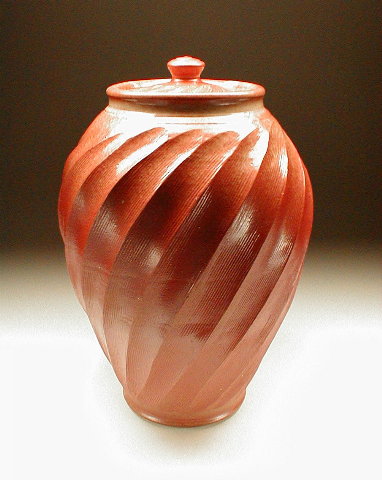

Oxidation firing is typically done in an electric kiln, but can also be done in a gas kiln. Oxygen is free to interact with the glazes when firing. Oxidation firing allow very bright, rich colors. High temperatures may be used, or low temperatures.
~~~~~~~~~~~~~~~~~~~~~~~~~~~~~~~~~~~~~~~~~~~~~~~~~~~~
 Reduction firing is typically done in a gas or other fuel burning kiln, since the corrosive effects wear out the elements on an electric kiln. In reduction firing, oxygen is prevented from interacting with the glazes during glaze maturation. This is done by adjusting the fuel in a gas kiln, or by adding organic material such as in Raku. As the organic material burns it uses up oxygen, leaving an oxygen-less environment. Reduction firing typically is used to obtain mottled, rich, earthy colors, often the iron from the clay shows through and gives a speckled look. Typically high temperatures are used in reduction firings.
Reduction firing is typically done in a gas or other fuel burning kiln, since the corrosive effects wear out the elements on an electric kiln. In reduction firing, oxygen is prevented from interacting with the glazes during glaze maturation. This is done by adjusting the fuel in a gas kiln, or by adding organic material such as in Raku. As the organic material burns it uses up oxygen, leaving an oxygen-less environment. Reduction firing typically is used to obtain mottled, rich, earthy colors, often the iron from the clay shows through and gives a speckled look. Typically high temperatures are used in reduction firings.
 In a reduction firing, the fire is searching for air. This causes it to leap from the opening when checking the firing as shown to the left. Here artist Jim Gremel checks the progress of a luster glaze reduction firing.
In a reduction firing, the fire is searching for air. This causes it to leap from the opening when checking the firing as shown to the left. Here artist Jim Gremel checks the progress of a luster glaze reduction firing.
Oxidation/reduction explanation from: http://www.bigceramicstore.com/information/types_of_firing.htm
Excellent site for glaze recipes of both types: http://www.ceramicstoday.com/stoneware.htm
Reduction fired jar: http://www.pinehillpottery.com/pinehillpottery/culturalshow/culturalpots.html
No comments:
Post a Comment